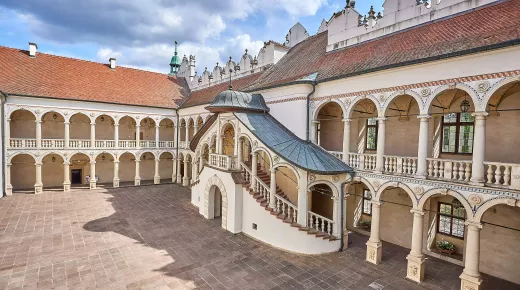In Leżajsk the most notable landmarks include the Bernardine Monastery with a Baroque church of the Annunciation of the Blessed Virgin Mary, featuring lush interior design
In the chapel of the Holy Mother you can admire the painting of Our Lady of Consolation dating from the latter half of the 1500s. Another highlight here, the magnificent Baroque pipe organs from the late 17th century rank among the oldest and most valuable in the world.
Each year the Bernardine Basilica hosts the International Festival of Organ and Chamber Music. The monastery is home to the Museum of the Bernardine Province, where visitors can admire paintings, sculptures, liturgical vessels, utensils and furniture, manuscripts and old prints as well as artefacts and souvenirs brought by missionaries from various countries. The monastery is surrounded by defensive walls with three fortified towers, built in the 1600s.
Leżajsk is also visited by Jewish pilgrims, coming in great numbers from Israel, Europe and America. The local cemetery is a resting place of the renowned Zaddik Elimelech Weisblum, also known as Majlech of Lizhensk (1717–1787), one of the founders of the Hasidic movement in Poland.
Each year in late September/early October the town hosts the International Hunting Festival
Worth seeing:
former manor estate of the District Governor, today home to the Museum of Leżajsk Region
-
figure of St. John of Nepomuk
-
late-Renaissance church of the Holy Trinity and of All Saints, from 1616
-
presbytery (formerly cloister of the Knights of the Holy Sepulchre)
-
former tserkov of the Dormition of the Virgin Mary, today church of the Divine Mercy of Jesus
-
town hall from the 1800s
-
historical urban layout
-
Mier Palace built around 1819
-
Swiss-style manor house
-
subprefect’s manor house from the 17th century
-
old sawmill
-
train station from 1896
-
building of the Public Library and Municipal Culture Centre (formerly Community Centre of Proświta Ukrainian Association)
-
building of the Regional Court from 1925
-
fortified watch tower from ca. 1616
-
building of the Cooperative Bank (former seat of Tax and Treasury Office)
-
statue of King Władysław Jagiełło
Photo: Zdzisław Janeczko



